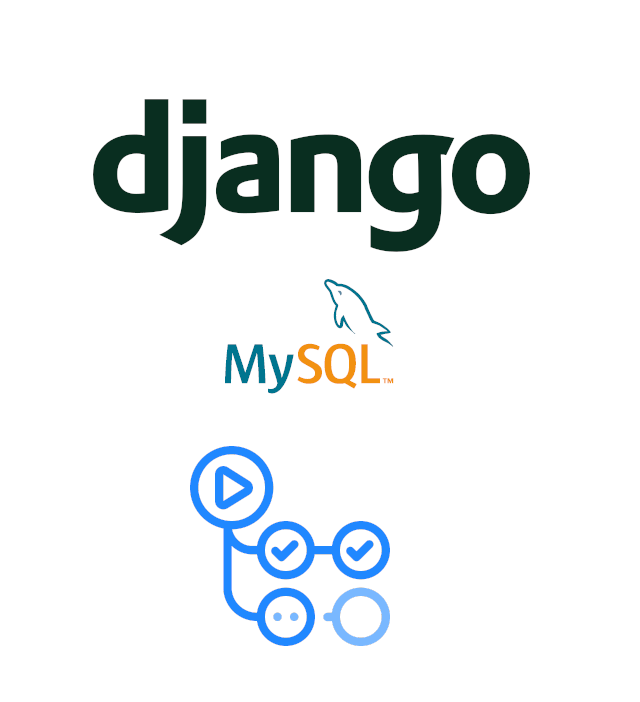Django+MySQL CI/CD with GitHub Actions

Introduction
In nowadays, when we develop a web application, we usually apply CI (Continuous Integration) and CD (Continous Deployment) to automate the processes of testing and deployment.
To run such automation, we use Jenkins [^1] and Travis [^2] in the old days. However, in this decade, there are lots of tool popping up for our needs, and one of them is GitHub Actions. As a web developer and GitHub lovers, I would like to use GitHub Actions for not only can be easily integrated with GitHub projects but also show off my ability to customize GitHub Actions [^3] for my needs. Therefore, I would like to share my note apply GitHub Actions (especially CI) on an example Django project using MySQL as its database.
Introduction of GitHub Actions
Just like other CI/CD platform, GitHub Actions is a yet-another platform for CI/CD. However, it has the following features:
- Highly integrated with GitHub Services. GitHub Actions can be invoked with arbitrary GitHub events. Therefore, if you host your repos on GitHub, you can consider to use GitHub Actions for better development experiences.
- Community-powered workflows. GitHub Actions lets you to create your own worflow and publish to its marketplace to share your work with others. For example, once I switch a Crystal project from Travis to GitHub Actions. The project needs CD of built website with custom domain and different repo name settings. And the work of GitHub Pages action [^4] helped me a lot with painless worflow switch.
- Self-hosted machines are permitted. You can not only run GitHub Actions on GitHub, but also your self-hosted machines with much more flexible configurations and better bargain! And the official document [^5] has great explainations to teach you how to achieve this.
As such, there are a lot of communities such as Julia Language [^6] switch their CI/CD workflows onto GitHub Actions. What’s more, these communities invent plenty of custom workflows for the ease of themselves and the developers using their project in the future.
Apply GitHub Actions on Django with MySQL
In this paragraph, I list the procedures how to apply GitHub Actions to your Django project.
You can see full example project in here.
1. Create Django project
Frist, create your Django project, namely example, by typing:
$ django-admin startproject example
Then add MySQL settings into DATABASES variable in example/settings.py:
DATABASES = {
'default': {
'ENGINE': os.environ.get('DBENGINE', ''),
'NAME': os.environ.get('DBNAME', ''),
'USER': os.environ.get('DBUSER', ''),
'PASSWORD': os.environ.get('DBPASSWORD', ''),
'HOST': os.environ.get('DBHOST', ''),
'PORT': os.environ.get('DBPORT', ''),
}
}
For demo purpose, I use environment variables to store the settings of databases.
2. Create Django App: users
Create a Django app called users by typing:
$ django-admin startapp users
3. Add Unit Tests in users
Because we want to run CI, we should add some unit test codes.
Substitude existing code with following codes in users/tests.py:
from django.test import TestCase
from django.contrib.auth.models import User
# Create your tests here.
class UserTestCase(TestCase):
def test_user(self):
username = 'cudachen'
password = 'carbotzergling'
u = User(username=username)
u.set_password(password)
u.save()
self.assertEqual(u.username, username)
self.assertTrue(u.check_password(password))
4. Add GitHub Actions CI
And here comes the main dish! But before adding GitHub Actions’ configuration, here are some common mistake I encounter as kindly reminders for you:
- branch : always make sure which branches you want to trigger GitHub Actions, or
you will be confused why GitHub Actions doesn’t working.
In this case, I would like to trigger GitHub Actions when pull request or push on
mainbranch. - env: as I use environment variables for database settings, make sure to set environment variables in each step you are going to use database, e.g. database migration and running unit tests.
- DB port: as indicated in [^7], GitHub Actions assign random port for each GitHub
Actions services defined by you.
In order to access these services (e.g. database) port with no failure, you have to use
jobs.<job_id>.services.<service_id>.portssyntax.
Then, here are the steps adding GitHub Actions configuration:
- Create directory called
.github/workflows. - In
.github/workflowsdirectory, adddjango-ci.yml(our GitHub Actions configuration) as below:
name: Django CI
on:
push:
branches: [ main ]
pull_request:
branches: [ main ]
jobs:
test:
runs-on: ubuntu-latest
strategy:
max-parallel: 4
matrix:
python-version: [3.7]
services:
mysql:
image: mysql:5.7
env:
MYSQL_ROOT_PASSWORD: zergling
MYSQL_DATABASE: mysql
ports: ['3306:3306']
steps:
- uses: actions/checkout@v2
- name: Set up Python $
uses: actions/setup-python@v2
with:
python-version: $
- name: Install Dependencies
run: |
python -m pip install --upgrade pip
pip install -r requirements.txt
- name: Run Migrations
run: python manage.py migrate
env:
DBENGINE: django.db.backends.mysql
DBNAME: mysql
DBUSER: root
DBPASSWORD: zergling
DBHOST: 127.0.0.1
DBPORT: $
- name: Run Tests
run: |
python manage.py test
env:
DBENGINE: django.db.backends.mysql
DBNAME: mysql
DBUSER: root
DBPASSWORD: zergling
DBHOST: 127.0.0.1
DBPORT: $
5. Push to GitHub and Enjoy!
After the above steps, push our project to GitHub, and GitHub Actions will start to work!
Trivia: Add GitHub Actions Badge for Showing CI Status
GitHub Actions provides status badge for showing CI status in ease.
Usually, you can add the badge in README.md like this:
[](https://github.com/<your-user-name>/<your-project-name>/actions/workflows/django-ci.yml)
Conclusion
In this post, I make an introduction how to apply CI/CD pipeline. I also introduce what is GitHub Actions and its characteristics. I then make a Django demo project using MySQL in order to show the processes running GitHub Actions, and leave some marks for avoiding common gotchas.
References
[^1] https://www.jenkins.io/
[^2] https://travis-ci.org/
[^3] https://github.com/features/actions
[^4] https://github.com/marketplace/actions/github-pages-action
[^5] https://docs.github.com/en/actions/hosting-your-own-runners/about-self-hosted-runners
[^6] https://julialang.org/
[^7] https://docs.github.com/en/actions/reference/workflow-syntax-for-github-actions#example-using-localhost